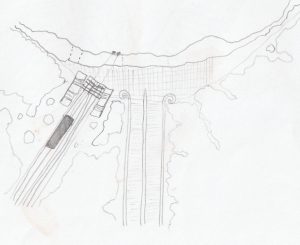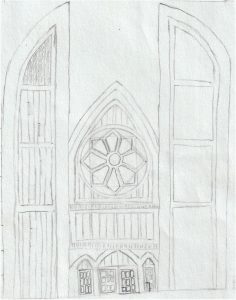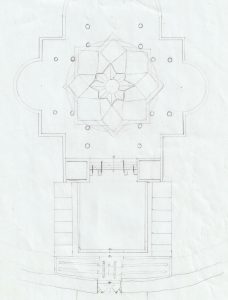
In the last article on world building I shared images and ideas about the origins of the cathedral complex, in this article I put forward the complete concept. After studying historical Spanish and Arab gardens as part of my college course I became interested in the architecture of places like the Alhambra Palace in Spain. Islamic Architecture, whether it be grand palaces or holy places, all use the same patterns of interlocking shapes and repeated themes. I started to imagine the cathedral being more open inside and covered by a central dome.

Let’s start at the entrance, in addition to the double stairway leading to the complex, I decided to add a cliff railway. Some people might be familiar with these as they are built at many seaside towns. The cliff railway is ingenious in its simplicity, as one cart goes down the other one rises, they offset each other’s weight, meaning only a little energy is required to pull one up and gently lower the other down. Whilst I imagine that the Artens were hugely intelligent, I reasoned that they would not think up a new solution, when was already one existing. Having the cathedral complex set at such a high point, would be difficult for elderly visitors or those coming on pilgrimages to receive blessings or medical treatment.

I briefly described the front of the cathedral in chapter one of ‘Beginnings’ this drawing shows the twin towers in more detail. The gap between the top points of each tower, is 40 m, each of the towers is 30 m wide and 140 m tall. Which makes the towers, the highest point of my cathedral complex, taller than the spire of Salisbury Cathedral which is 123 m. On this scale the double doors at the centre of the building will be each 10 m wide by 14 metres tall. No wonder Keyanna couldn’t push them open, I described how she found a side door but more accurately she entered through a wicket gate, which is a door within a door. I envisaged that the Artens would open the grand doors using electric motors or hydraulics, but making it seem as if it was a miracle demonstrating their divinity.
The whole purpose of the cathedral was to impress humans who had not seen buildings on such a scale before. Anyone who has been to York, England, can understand a little of what I mean, as the Minster is still the tallest structure within the city walls. I imagined that humans, before the arrival of the Artens in the world of Gear, were capable of building grand monuments, palaces and other huge structures, but mostly they built only two or three stories tall. I’ve also depicted the cathedral clad partly in sheet glass, I imagined that the outer walls of the cathedral would be rendered white, and the glass panels be darkened to allow high reflection to dazzle the pilgrims. The main frontage of the cathedral is east facing, and it would act like a mirror for the rising sun. Amongst the dark glass is the great window which I’ve depicted showing the eight-pointed star of Art.

This picture shows the layout that Keyanna experienced as she passed into the cathedral. At the bottom of the image are the doors leading into the cloakroom with its cubbyholes, just as in a mosque people would be asked to leave their shoes, coats and bags behind. Just imagine trying to find your pair of shoes in one of six 40 m long racks of cubbyholes. After the entrance lobby is the courtyard which I have called Pilgrims Plaza, is it is flanked by two buildings that sell everything that a pilgrim might need, from holy books, postcards, divine medicines, memorabilia, charms and blessed objects. Whilst most Artens were concerned only with science and innovation, there were enough people in administration with good business sense, and they would sell anything they could to the hordes of pilgrims that came to their city.
Beyond the plaza is a floorplan of the cathedral. The single central room has more in common with a mosque than a Christian cathedral, and I describe the floor as been made of white marble, inlaid with decorative patterns of bluestone. I described a single stained-glass window, in chapter one of ‘Beginnings’, as showing a scene of Artens splendid in their battle armour with several flying ships in the skies above them, this was just one of twenty-seven stained-glass windows that surrounded the central hall.
Covering the central hall is an 80 m wide dome, on the inside of this is painted a single fresco depicting the Artens in angel forms, featuring all the Guiders, from the first Guider, Maria Melba, to the last Guider, Neon Kenzake. At the centre of the dome is a circular, clear glass window, which lets in a pillar of pure light which is specially angled to strike the main altar at key times of the year.
At the far eastern end of the hall is the high altar which will have a similar setup to those in a catholic cathedral. Designed like the rest of the structure to show off to human pilgrims, the high altar depicts nine Arten saints and the first profit of the Artens receiving the holy shoes. The whole marble fresco is carved to a scale larger-than-life and all the details are picked out in silver gilt and semiprecious stones. The Artens never wasted precious resources like gold or diamonds in flashy displays such as these, as they were too useful for circuitry.
